

The Coleophoridae of Armenia collected by Ole Karsholt in 2011. Contributions to the knowledge of the Coleophoridae CXXXI (Lepidoptera: Coleophoridae)
Los Coleophoridae de Armenia colectados por Ole Karsholt en 2011. Contribución al conocimiento de los Coleophoridae CXXXI (Lepidoptera: Coleophoridae)
The Coleophoridae of Armenia collected by Ole Karsholt in 2011. Contributions to the knowledge of the Coleophoridae CXXXI (Lepidoptera: Coleophoridae)
SHILAP Revista de lepidopterología, vol. 44, núm. 173, 2016
Sociedad Hispano-Luso-Americana de Lepidopterología
Recepción: 16 Marzo 2015
Aprobación: 20 Abril 2015
Abstract: This work presents the results of the study on Coleophoridae collected in Armenia by Ole Karsholt in 2011. Thirty species have been identified, almost all new to Armenia. Four of these are new to science and are described with the following names; Coleophora maculata Baldizzone, sp. n., C. landryi Baldizzone, sp. n., C. noravanki Baldizzone, sp. n., C. annekristinae Baldizzone, sp. n.
Keywords: Lepidoptera, Coleophoridae, new species, Armenia.
Resumen: Este trabajo presenta el resultado de un estudio sobre Coleophoridae colectados en Armenia por Ole Karsholt en 2011. Treinta especies han sido identificadas, casi todas nuevas para Armenia. Cuatro de estas son nuevas para la ciencia y se describen con los siguientes nombres: Coleophora maculata Baldizzone, sp. n., C. landryi Baldizzone, sp. n., C. noravanki Baldizzone, sp. n., C. annekristinae Baldizzone, sp. n.
Palabras clave: Lepidoptera, Coleophoridae, nuevas especies, Armenia.
In 2011 the noted Danish micro-lepidopterist Ole Karsholt carried out a research expedition to the Republic of Armenia, accompanied by his wife Anne Kristine, who actively collaborated in collecting specimens. Collecting was carried out primarily by UV light trap. In all 100 Coleophoridae were collected and sent to me for study. I identified 30 species, of which four are new to science. The specimens have been deposited in the Zoologisk Museum, Natural History Museum of Denmark, Copenhagen (ZMUC) and in the collection of Baldizzone (Bldz). Two of the new species were successfully DNA barcoded and their Barcode Index Numbers (BINs) are indicated under the species headings and can be accessed at http://www.boldsystems.org/index.php/databases under the “BIN database”. The Barcode Identification Numbers (RATNASINGHAM & HEBERT, 2013) in BOLD are used as registry designations for barcode clusters. Neighbor-joining trees and genetic distances were calculated with BOLD using the Kimura two-parameter (K2P) model of base substitution with the Kalign alignment option. Details of the barcoded specimens and their photographs are available through the following dataset (http://dx.doi.org/10.5883/DS-CNEPETA). The same DOI provides access to the sequence records, trace files, and primer sequences used for PCR amplification, together with GenBank accession numbers.
Coleophora ochripennella Zeller, 1849 Armenia, Kotayk prov., Tsaghkadzor, 1870-2350 m, 9-11-VII-2011, 3 11. Armenia, prov. Tavush, Dilijan, 1340-1450 m, 12-14-VII-2011, 5 00 Geographical distribution: Central and southern part of Europe, Denmark, The Netherlands, Greece, Turkey, the Caucasus Region, and Iran. New record for Armenia.
Coleophora gryphipennella (Hübner, 1796) Armenia, Kotayk prov., Tsaghkadzor, 1870-2350 m, 9-11-VII-2011, 11 . Geographical distribution: Almost all of Europe, central and eastern Siberia, and Japan. New record for Armenia.
Coleophora badiipennella (Duponchel, 1843) Armenia, prov. Tavush, Dilijan, 1340-1450 m, 12-14-VII-2011, 2 11. Armenia, prov. Vajots Dzor, 10 km SE Areni, Noravank, 1600 m, 15-17-VII-2011, 1 0. Geographical distribution: Almost all of Europe, the Caucasus Region, Russia, Iran, and Canada. New record for Armenia.
Coleophora serratella (Linnaeus, 1761) Armenia, Kotayk prov., Tsaghkadzor, 1870-2350 m, 9-11-VII-2011, 1 0. Geographical distribution: Almost all of Europe, the Caucasus Region, Russia including Siberia, Japan, Canada, and U.S.A. New record for Armenia.
Coleophora nairica (Fakovitsh, 1991) Armenia, prov. Tavush, Dilijan, 1340-1450 m, 12-14-VII-2011, 3 11. Geographical distribution: The species is known only from Armenia and the northern Caucasus.
Coleophora albitarsella Zeller, 1849 Armenia, prov. Tavush, Dilijan, 1340-1450 m, 12-14-VII-2011, 3 11 . Geographical distribution: Present in almost all of Europe and the Caucasus Region. New record for Armenia.
Coleophora albicostella (Duponchel, 1842) Armenia, prov. Tavush, Dilijan, 1340-1450 m, 12-14-VII-2011, 11 . Geographical distribution: Present in almost all of Europe, Turkey, the Caucasus Region, Syria, Lebanon, Siberia and the Altai Region of Russia. New record for Armenia.
Coleophora deauratella Lienig & Zeller, 1846 Armenia, Kotayk prov., Tsaghkadzor, 1870-2350 m, 9-11-VII-2011, 2 11 , 2 00 Geographical distribution: Present in almost all of Europe, Turkey, the Caucasus Region, Syria, Lebanon, Russia (Siberia), China, Canada, and U.S.A. New record for Armenia.
Coleophora paramayrella Nel, 1993 Armenia, prov. Tavush, Dilijan, 1340-1450 m, 12-14-VII-2011, 1 0. Armenia, Kotayk prov., Tsaghkadzor, 1870-2350 m, 9-11-VII-2011, 1 0. Geographical distribution: Known from southern France, Italy, Slovenia, Slovakia, Hungary, Ukraine, Macedonia, and Greece (Corfu). New record for Armenia.
Coleophora albiochrella Toll & Amsel, 1967 Armenia, prov. Vajots Dzor, 10 km SE Areni, Noravank, 1600 m, 15-17-VII-2011, 1 0. Geographical distribution: Known from Turkey, Iran, and Afghanistan. New record for Armenia.
Coleophora eurasiatica Baldizzone, 1989 Armenia, prov. Vajots Dzor, 10 km SE Areni, Noravank, 1600 m, 15-17-VII-2011, 1 1, 2 00. Geographical distribution: Present in Hungary, Bulgaria, Russia (Lower Volga, S Ural and the extreme East, Altai), Mongolia, China, and South Korea. New record for Armenia.
Coleophora maculata Baldizzone, sp. n. (Fig. 1)
Holotype 1 (PG Bldz 15828), Database # | CNCLEP | 00111720: “Armenia, prov. Vajots Dzor, 10 km SE Areni Noravank, 1600 m | 349º 41’ 07”N | 45º 14’ 02”E, 15-17-VII-2011, O. Karsholt”, coll. ZMUC. Barcode Index Number BOLD: ACM6927. Paratypes: 4 11 (PG Bldz 15771), idem, coll. ZMUC; 1 1, Database # | CNCLEP | 00111721, idem, coll. Baldizzone.
Description: Wingspan 15-16 mm. Head white, tinged grey above the eyes. Antenna with White basal section and tuft of short erect scales; flagellum white. Labial palpus white with some Brown scales on the outside; second segment twice as long as third. Proboscis absent. Thorax white. Tegula white. Forewing white with tinge of ivory; sprinkled with dark brown scales which widen to form longitudinal streaks especially in first half of subcostal area, apical area, on ventral edge of cell, in basal fold, and along dorsum. Costal cilia white, dorsal cilia is light grey. Hindwing pale grey, with cilia coloured as those of forewing. Abdomen shiny white.
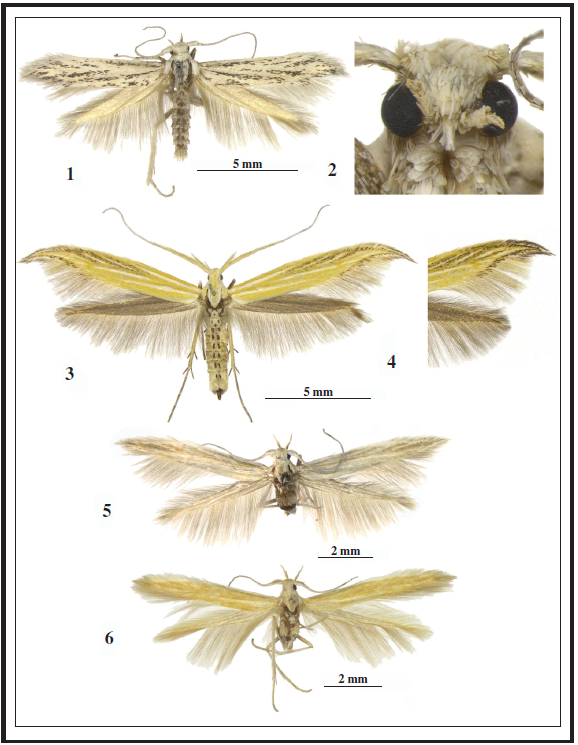
Male genitalia (Figs. 7, 8, 9): Terminal part of gnathos wide, oval. Tegumen short, stubby, slightly constricted medially with pedunculus moderately dilated. Transtilla short, ribbon-like, not separated medially. Cucullus short, slightly restricted at base. Valva with oblique ventral edge. Aedeagus short conical, sclerotized with cribrose appearance only on the ventral side. Sacculus sub-triangular with thick ventral edge, terminating in heavily sclerotized beak-shaped expansion at dorsal angle. Female genitalia: Unknown.
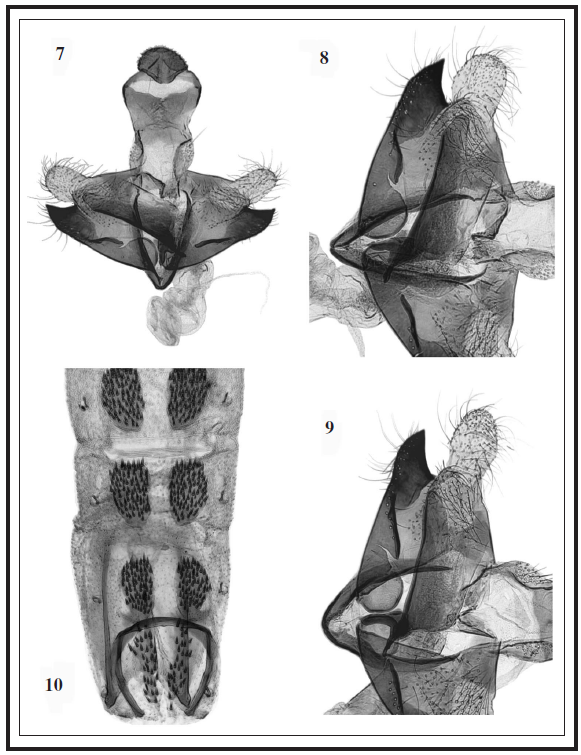
7. Male genitalia (PG Bldz 15771), paratype. 8. Detailed close-up of valva, aedeagus and sacculus. 9. Same detail (PG Bldz 15828), holotype. 10. Abdominal tergites (PG Bldz 15828).
Abdominal apodemes (Fig. 10): Postero-lateral bars absent, transverse bar slightly curved. Tergal patches covered with bristly short conical spines, those on 3rd tergite 0.5 times longer than wide.
Diagnosis: Species of average size in the Coleophoridae family, characterized by the dirty White ground colour overlaid with streaks of dark scales of the forewings and the absence of a proboscis (Fig. 2). It belongs to a group of species that live in arid sub-desert areas, like Coleophora hamata Falkovitsh, 1972, a species described from Mongolia and recorded also from Uzbekistan (BALDIZZONE et al., 2006), C. elephantellaFalkovish, 1970 from Uzbekistan, and C. pachyderma Baldizzone, 1994 from Iran. The male genitalia are most similar to those of C. hamata. From the original description of Falkovisth the latter species is indicated as larger (17-19 mm) and with 4-5 large brown scales placed in the apical part of the wing. In male genitalia, maculata has a stubbier structure both with regards to the tegumen and the sacculus, of which the lateral protrusion is proportionally larger and shorter than that of hamata, whilst the ventral edge is closer and sclerotized; the aedeagus of maculata is shorter, with the ventral edge less uniformly chitinized; in hamata there is a spherically shaped cornutus, which is absent in maculata.
The DNA analysis carried out on two of the specimens of maculata revealed that their barcodes are 7.6% distant from the paratype of hamata.
A characteristic component of the new species is the absence of a proboscis, a detail that is not mentioned in the description of C. hamata. The absence of a proboscis and the greatly reduced mouth parts in other species of Coleophoridae has been discussed in a recent paper on C. micronotella Toll, 1956 (LANDRY & BALDIZZONE, 2014).
Geographical distribution: The new species, of which the female and biology are unknown, is recorded only from Armenia.
Etymology: The name is derived from the characteristic elongated markings on the forewings.
Coleophora felixella Baldizzone, 1994 Armenia, prov. Tavush, Dilijan, 1340-1450 m, 12-14-VII-2011, 6 11, 2 00. Geographical distribution: known only from Armenia and the northern Caucasus Region.
Coleophora vulpecula Zeller, 1849 Armenia, prov. Vajots Dzor, 10 km SE Areni, Noravank, 1600 m, 15-17-VII-2011, 1 1. Geographical distribution: Central and southern Europe, Turkey, Iran, Afghanistan, Russia (Altai and SW Siberia). New record for Armenia.
Coleophora zelleriella Heinemann, 1854 Armenia, prov. Tavush, Dilijan, 1340-1450 m, 12-14-VII-2011, 1 1. Geographical distribution: Almost all of Europe, Russia (south Ural, far East), the Caucasus Region, Syria, Iran, and Japan. New record for Armenia.
Coleophora albipennella Staudinger, 1879 Armenia, prov. Tavush, Dilijan, 1340-1450 m, 12-14-VII-2011, 1 1. Armenia, prov. Vajots Dzor, 10 km SE Areni, Noravank, 1600 m, 15-17-VII-2011, 1 0. Geographical distribution: Turkey, Armenia, Kazakhstan and Iran.
Coleophora gallipennella (Hübner, 1796) Armenia, Kotayk prov., Tsaghkadzor, 1870-2350 m, 9-11-VII-2011, 3 11. Geographical distribution: Present in almost all of Europe, Turkey, the Caucasus Region, Russia (Lower Volga, SW Siberia, Altai), and Mongolia. New record for Armenia.
Coleophora coronillae Zeller, 1849 Armenia, prov. Tavush, Dilijan, 1340-1450 m, 12-14-VII-2011, 5 11, 1 0. Geographical distribution: The Netherlands, central and southern Europe, Ukraine, Russia (Lower Volga), Turkey, the Caucasus Region, Armenia, Iran.
Coleophora conspicuella Zeller, 1849 Armenia, prov. Vajots Dzor, 10 km SE Areni, Noravank, 1600 m, 15-17-VII-2011, 11 11. Geographical distribution: Present in almost all of Europe, Turkey, Iraq, Syria, the Caucasus Region, Kazakhstan, Russia (lower Volga, S Ural, Altai, extreme far East). New record for Armenia.
Coleophora symphistropha (Reznik, 1976) Armenia, prov. Vajots Dzor, 10 km SE Areni, Noravank, 1600 m, 15-17-VII-2011, 1 0. Geographical distribution: Turkey, , Iraq, Syria, Kazakhstan, Armenia, Azerbaijan, and Iran.
Coleophora landryi Baldizzone, sp. n. (Figs. 3, 4)
Holotype 1 (PG Bldz 15836): “3.u[nd].4-VIII-1976 | Russ.[issche] Armenia | Geghard, 1700 m, 40 km | östl.[ich] Eriwan | Kasy & Vartian”. In coll. Baldizzone, Asti. Barcode Index Number: BOLD: AAC8630. Paratypes: 3 11 (PG Bldz 8944), 4 00 (PG 15834, 15835), same locality and date of the holotype, coll. Baldizzone; ibidem, 3 11 (PG Bldz 6369, 6371), 1 0 PG Bldz 6370), ibidem, 28-29-VII-1976, coll. Baldizzone. 1 1 (PG Bldz 15777), 1 0 (PG Bldz 15778), Armenia, prov. Vajots Dzor, 10 km SE Areni, Noravank, 1600 m, 349º 41’ 07”N | 45º 14’ 02”E, 15-17-VII- 2011, O. Karsholt leg., coll. ZMUC. 1 1, Turkey, Erzurum, 40 km nördl. Aºkale, Tasagil, ca. 1600 m, 20-VII-1996, leg. G. Baisch, coll. Baisch; 1 0, Turkey, Erzincan, 40 km östl. Erzincan, Bagirpasa Dagi, 1700 m, bei Pülümür, 15-16-VII-1992, leg. G. Baisch, coll. Baisch; 3 11 , 2 00, Turkey, Erzincan, 5 km östl. Altköy, Fahrweg Kürelik, 5-VII-2001, leg. G. Baisch, coll. Baisch, coll. Canadian National Collection, Ottawa and coll. Baldizzone; 1 1, 1 0, ibidem, 6-VII-2001, leg. G. Baisch, coll. Baldizzone; 1 0, ibidem, 24-VII-2001, leg. G. Baisch, coll. Baisch; 3 11, 3 00, Turkey, Kars , 7 - 10 km S Sarikamis, 2000 m, 10-14-VII-1989, St. 523, H. v. Oorshot, W. de Prins, F. Coenen & R. Koolbergen, coll. Van der Wolf; 1 1, Turkey, Hakkari, ca. 20 km WNW Yüksekova, 1800 m, 10-VII-1990, St. 613, leg. H. v. d. Bink, W. d. Prins, coll. Van der Wolf.
Description: Wingspan 16-18 mm. Head suffused with yellow cream on vertex. Antenna with white basal section supplied with thick tuft of long erect scales, white coloured inside and yellow cream on the outside; flagellum white, covered with long cream-coloured scales in basal half. Labial palpus white with second segment 2.5 times longer than third. Forewing yellow cream, furrowed with several silvery stripes, more or less visible on specimens: one subcostal stripe starting at base of wing and interrupted about halfway, four short stripes in apical area, another median stripe as long as half of wing, another along dorsal vein starting broad and tapered, ending before wing edge, and another short stripe along dorsum starting at base; wing apex very falcate with edging of Brown scales, more or less darker and wider than those along base of costal edge, and partly so of those on dorsum. Costal cilia yellow cream in proximal half and tinged brown apically in distal half; dorsal cilia grey except for distal section which is almost completely tinged brown. Hindwing brown, cilia brown.
Male genitalia (Figs. 11, 12, 13): Terminal part of gnathos globular. Tegumen narrow and elongate with base of pedunculus outwardly protruded. Transtilla thin and linear, divided medially. Valva large with ventral edge rounded. Cucullus elongate and quite narrow, oblique, with base slightly larger than rounded apex and a small protrusion shaped like obtuse triangle at base of upper edge. Sacculus thickened on ventral edge, the latter rounded and slightly protruding over outer edge. Aedeagus conical, stubby, large, lightly sclerotized. Cornuti small, numerous tightly grouped in long braid.
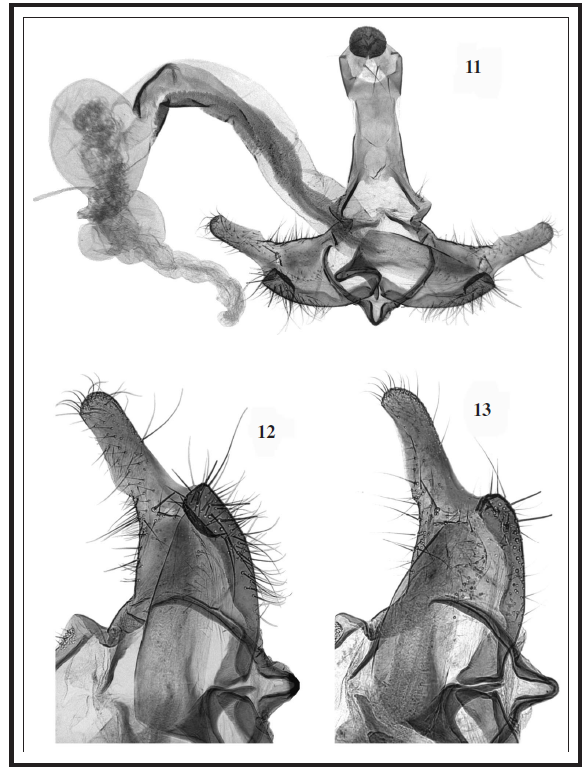
11. Male genitalia (PG Bldz 15777), paratype. 12. Detailed close-up of male genitalia. 13. Same detail (PG Bldz 15838), holotype.
Female genitalia (Figs. 14, 15, 16): Anal papillae narrow, long, well sclerotized. Posterior apophyses twice as long as anterior ones, which are large and robust. Sterigma conical with two robust longitudinal extensions bordering ostium bursae; extensions slightly oblique, concave on outside, distal part rounded, covered with thin long spines. Ostium bursae elongate. Distal part of colliculum large, covered with thin spines; proximal part thin with well sclerotized walls. Ductus bursae very long, with median band that starts in spiral part near inception of the ductus seminalis and ends dilated in wider part of colliculum; spinulate section of ductus about 8 times longer tan sterigma, transparent section the median is about 5 times long the sterigma, completely transparent section of ductus 8 times length of sterigma; this is joined with corpus bursae by tubular section as long as sterigma, wider than the rest of the ductus and finely covered with dots. The corpus bursae is spherical with a large signum in the shape of a leaf.
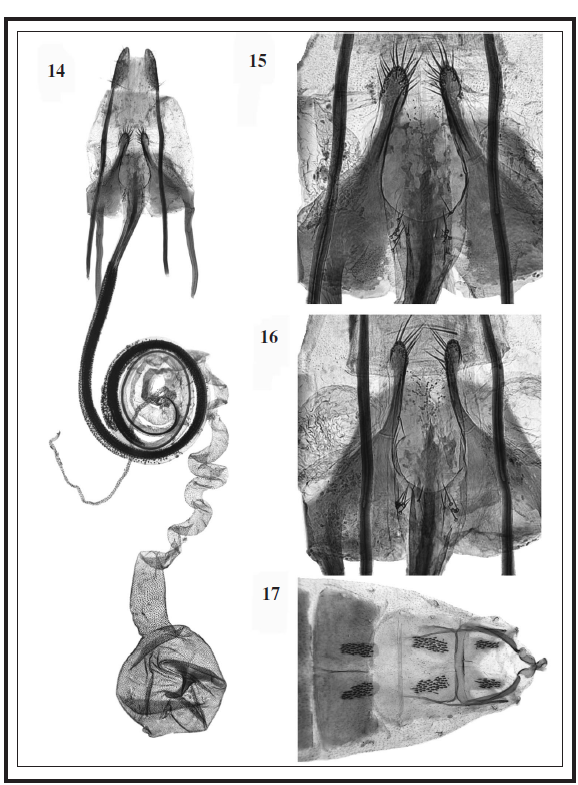
14. Female genitalia (PG Bldz 15835), paratype. 15. Detailed close-up of sterigma and colliculum. 16. Same detail (PG Bldz 15834), paratype. 17. Abdominal tergites (PG Bldz 15777).
Abdominal apodemes (Fig. 17): Antero-lateral bars almost twice as long as postero-lateral bars. Transversal bar large with proximal edge straight, thicker centrally and distal edge slightly convex and thickened with respect to tergal patches. Tergal patches covered with short conical spines, about 2 times longer than wide (3rd tergite).
Diagnosis: Species of a medium-large size in the Coleophoridae family, characterized by a pronouncedly falcate forewing and the strong yellow cream colour, with brown edging at the apex in the falcate area. It belongs to the C. lixella, Zeller, 1849, group. It is distinguished above all by the characteristic shape of the wing apex, colouration, and the absence of the brown edging around the white stripes. With regards to the genitalia, the male has the narrowest cucullus among all the species of the group, and the sacculus is small and not very pronounced from the ventral side; in the female genitalia, the shape of the sterigma is unmistakable, especially the two chitinized longitudinal extensions, which are similar to those of the two larger species, C. nevadella Baldizzone, 1985 and C. nepetellae Baldizzone & Nel, 2014; compared to the latter two species, the extensions in C. landryi are more narrowed medially with their apices extended obliquely, with a wider base as well as wider ostium bursae.
Note: In 1994 I had treated some specimens of this species as C. lixella and speculated that they could be a subspecies. In successive investigations and more detailed study of the lixella group, it became evident that it represented a distinct species. Geographical distribution: The species is known from Armenia and eastern Turkey.
Etymology: Coleophora landryi Baldizzone, sp. n. is dedicated to my friend Jean-François Landry, eminent micro-lepidopterist, who made a fundamental contribution to the knowledge of the Coleophoridae.
Note about DNA barcodes: Barcoded specimens of this species were included in the DNA barcode analysis of the Coleophora lixella group by BALDIZZONE et al. (2014), where they were labelled “lixella-group II”. See that reference for full details.
Coleophora caucasica Stainton, 1867 Armenia, Kotayk prov., Tsaghkadzor, 1870-2350 m, 9-11-VII-2011, 2 11. Geographical distribution: Turkey, northern Caucasus Region, Georgia, and Armenia. The species has a wider distribution and is also present in Europe where it has been confused with other species of the lixella group. The genitalia and other informations will be presented in a separate monograph on the Coleophora lixella group which is in preparation.
Coleophora versurella Zeller, 1849 Armenia, prov. Tavush, Dilijan, 1340-1450 m, 12-14-VII-2011, 6 11 . Geographical distribution: Widely distributed in the Palearctic region, present also in India, New Zealand, Canada, U.S.A., Argentina, and Chile. New record for Armenia.
Coleophora luteolella Staudinger, 1880 Armenia, prov. Tavush, Dilijan, 1340-1450 m, 12-14-VII-2011, 1 1 . Geographical distribution: In part of southern Europe, Morocco, Turkey, Iran, and Afghanistan. New record for Armenia.
Coleophora remizella Baldizzone, 1983 Armenia, prov. Vajots Dzor, 10 km SE Areni, Noravank, 1600 m, 15-17-VII-2011, 4 11, 1 0. Geographical distribution: Known from part of Central Europe (Slovakia, Romania, Bulgaria, Ukraine) and Russia (lower Volga). New record for Armenia.
Coleophora noravanki Baldizzone, sp. n. (Fig. 5)
Holotype 1 (PG Bldz 15807): “Armenia, prov. Vajots Dzor, 10 km SE Areni Noravank, 1600 m | 349º 41’ 07”N | 45º 14’ 02”E, 15-17-VII-2011, O. Karsholt”, coll. ZMUC. Description: Wingspan 13 mm. Head white, suffused with ochre on vertex. Antenna with White basal section and tuft of short erect scales; flagellum white. Labial palpus ochre laterally and White dorsally, with second segment about 1.5 times longer than third. Thorax white, suffused with ochre centrally. Tegula white, tinged ochre on outside. Forewing pale ochre and mostly covered with White stripes: costal stripe thin and extended to start of cilia which are tinged grey to apex, a small ochre coloured tuft separates them from the dorsal cilia; one subcostal stripe, one in cell, one in wing fold exteded to outer margin and one along dorsum; between these last two ochre ground colour palest, barely evident, darkest towards wing apex. Costal cilia grey. Hindwing and cilia grey. Abdomen dirty white colour.
Male genitalia (Figs. 18, 19, 20): Terminal part of gnathos small and globular. Tegumen narrow medially and centrally reinforced with sclerotized bar, pedunculi basally dilated. Transtilla elongate and rounded at apex. Valva large with rounded ventral edge. Cucullus elongate, larger at apex than base. Sacculus very sclerotized, outer edge curved at ventral side, with elongate extension restricted to dorsal side and extended to medial part of cucullus; internally with sclerotized triangular tooth at base of extension. Aedeagus made of two very sclerotized and pointed bars, one of which slightly longer and more sharply pointed than the other. A single, very small cornutus spine-shaped with thicker base.
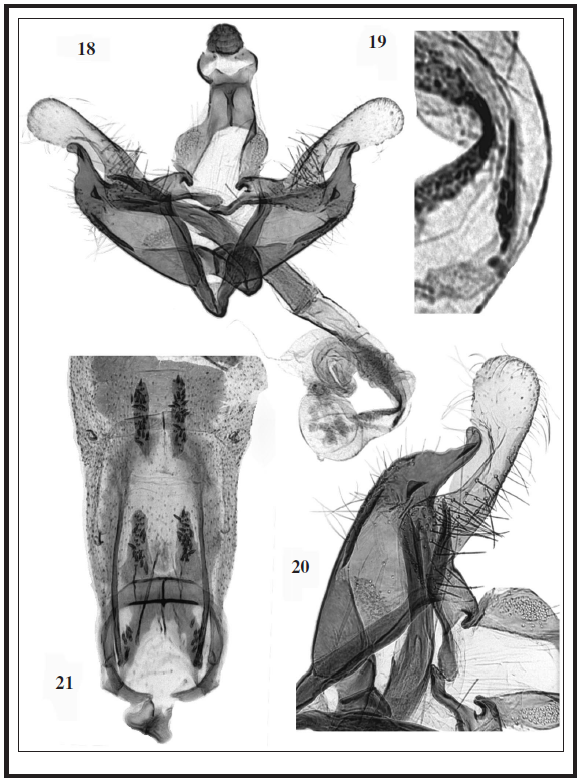
18. Male genitalia (PG Bldz 15807), holotype. 19. Greatly magnified cornutus. 20. Detailed close up of valva, aedeagus and sacculus. 21. Abdominal tergites.
Abdominal apodemes (Fig. 21): Postero-lateral bars absent, transverse bar slightly curved and much thickened. Tergal patches covered with short conical spines, (3rd tergite) about 7 times longer than wide.
Diagnosis: Species of medium-small size, light coloured, with whitish shades prevailing over a light ochre base on the forewings. Based on the male genitalia it belongs to the Coleophora odorariella Mühlig & Frey, 1857, group, a species which is recorded in Europe from Turkey (BALDIZZONE et al., 2006). Within this group there are also C. moronella Falkovisth, 1975, known from Mongolia and the Altai Region of Russia, C. mediocris Falkovish, 1977, known from Mongolia and C. gurunensis Baldizzone, 1994, known from Turkey. In all these species the male genitalia are characterized by the moderately long, curved extension on the dorsal side of the sacculus, with a triangular blunt denticle at the base. From all these species C. noravanki is separated primarily by the shape of the aedeagus, which is short, stubby, and much more sclerotized, and by the cornutus which is much smaller and spine shaped.
Geographical distribution: The species, of which the female and biology are unknown, is recorded only from the type locality.
Etymology: The name is derived from the collection locality, Noravank.
Coleophora alabardata Baldizzone, 1994 Armenia, prov. Vajots Dzor, 10 km SE Areni, Noravank, 1600 m, 15-17-VII-2011, 7 11. Geographical distribution: The species was known only from Iran. New record for Armenia.
Coleophora acanthopylli (Falkovitsh, 1989) Armenia, prov. Vajots Dzor, 10 km SE Areni, Noravank, 1600 m, 15-17-VII-2011, 4 11. Geographical distribution: Known from Turkmenistan, Iran, and Afghanistan. New record for Armenia.
Coleophora annekristinae Baldizzone, sp. n. (Fig. 6)
Holotype 1 (PG Bldz 15802): “Armenia, prov. Vajots Dzor, 10 km SE Areni Noravank, 1600 m | 349º 41’ 07”N | 45º 14’ 02”E, 15-17-VII-2011, O. Karsholt”, coll. ZMUC. Paratypes: 1 1. (PG Bldz15797), 4 00 (PG Bldz 15800, 15801, 15803), idem, coll. ZMUC e coll. Baldizzone.
Description: Wingspan 9-11 mm. Head light ochre, slightly darker on vertex. Antenna with basal section white dorsally and ferruginous ochre ventrally, without tuft; flagellum completely white. Labial palpus white suffused ochre on outside of second segment, which is twice as long as third segment. Thorax white suffused ochre in middle. Tegula white. Forewing shiny ochre; thin white stripe extended along costa and widening on the costal cilia, without reaching apex; apical cilia ochre; second short and very thin white stripe on inferior edge of cell and third thin line along wing fold ending before edge of wing. Dorsal cilia light grey. Hindwing and cilia light grey. Abdomen white tinged ochre.
Male genitalia (Figs. 22, 23, 24, 25): Terminal part of gnathos globular. Tegumen constricted to base of gnathos arms, triangularly widened, pedunculi moderately dilated on outside. Transtilla short and rhombic. Valva small with oval ventral edge. Cucullus quite large, elongate, curved at apex. Sacculus well sclerotized with lateral edge curved, ventral edge slightly expanded, and with large curved sharp horn-shaped process extended beyond dorsal edge of cucullus. Aedeagus long and curved, made up from two sclerotized bars, more sclerotized dorsally, shorter bar with small triangular tooth before middle. A single, long, thin spiniform cornutus with slightly larger base.
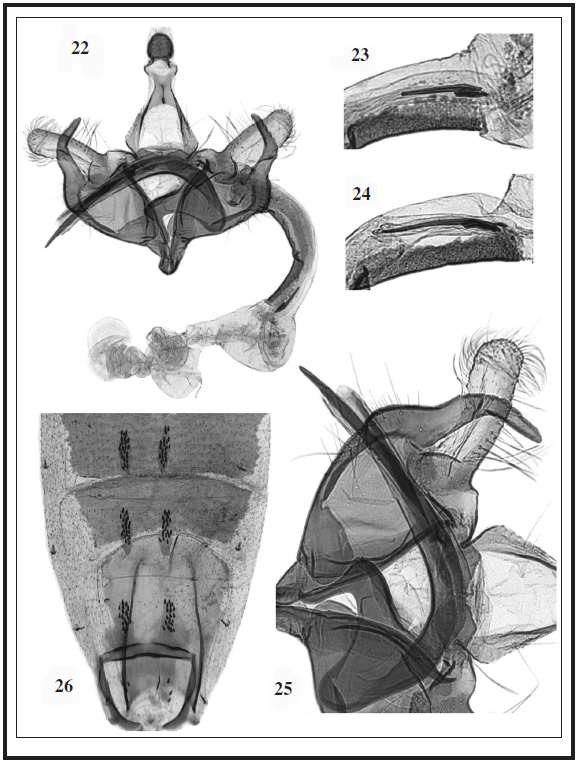
22. Male genitalia (PG Bldz 15802), paratype. 23. Greatly magnified cornutus (PG Bldz 15802). 24. Same detail (PG Bldz 15797), holotype. 25. Detailed close up of valva, aedeagus and sacculus. 26. Abdominal tergites (PG Bldz 15802).
Note: One of the two examined male genitalia had a shorter cornutus because the terminal part was broken. In the bursa of one of the three female genitalia examined there is a fragment of a cornutus. It is presumed that the cornutus broke during copulation. This observation is quite frequent in the Coleophoridae.
Female genitalia (Figs. 27, 28, 29): Anal papillae narrow and elongate. Posterior apophyses slightly longer than twice length of anterior apophyses. Sterigma trapezoidal, larger and more sclerotized in proximal half, distal edge rounded, deeply engraved corresponding to ostium bursae which is small, ogival in shape. Colliculum 0.5 times as long as sterigma, uniformly tubular, very chitinized, connection to ductus bursae via asymmetrical loop. Ductus bursae with median band extended over entire length of spinulate section and becoming more slim and fragmented before sclerotized and transparent section; spinulate section of ductus 3 times longer than sterigma, folded and extending about the same length as the previous section, sclerotized but without spines, dilated at inception of ductus seminalis; transparent part of ductus as long as previous section but narrower, widened slightly before inception into bursa,; corpus bursae round, with leaf shaped signum and sharp basal plate.
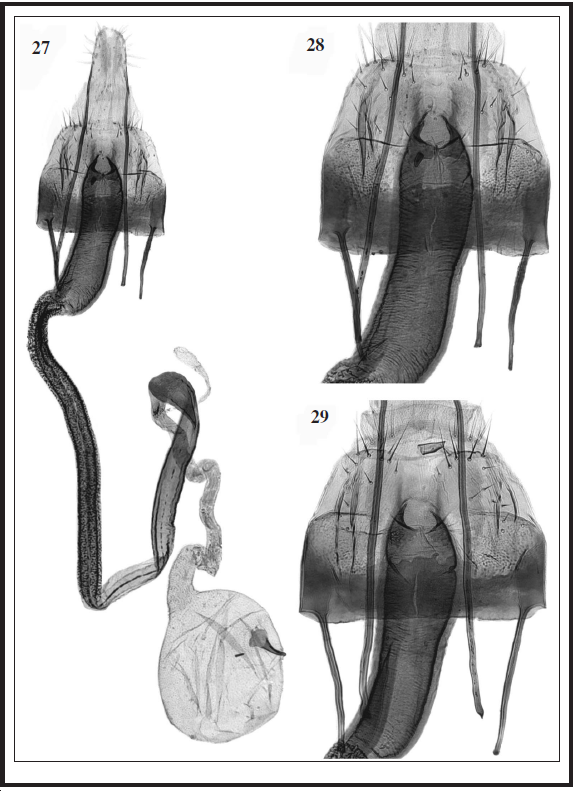
27. Female genitalia (PG Bldz 15803), paratype. 28. Detailed closup of sterigma and colliculum. 29. Same detail (PG Bldz 15800), paratype.
Abdominal apodemes (Fig. 26): Postero-lateral bars absent, transverse bar slightly convex with proximal edge more sclerotized centrally and distal edge sclerotized at base of tergal patches. Tergal patches covered with short, conical spines, (3rd tergite) about 4 times longer than wide in male and 2.5 times wider in female.
Diagnosis: Species of a medium-small size, characterized by the overall slightly shiny ochre colour. The male genitalia is characterized by the long, horn-like extension on the dorsal side of the sacculus, something that makes it similar to Coleophora lima Falkovisth, 1975, a species known only from Mongolia, but distinguished by several features of the sacculus, shape of the aedeagus and cornutus. The female of C. lima is not known and could not be compared with that of C. annekristinae which has a unique aspect that does not permit it to be allow comparasion to other described species.
Geographical distribution: The species, of which the biology is unknown, is recorded only from Armenia.
Etymology: The species is dedicated to Mrs. Anne Kristine Karsholt in acknowledgement of her contribution to the research activities of Ole Karsholt during the trip to Armenia.
Agradecimientos
I thank Ole Karsholt of the ZMUC, Günther Baisch (Biberach an der Riss, Germany) and Hugo W. van der Wolf (Nuenen, The Netherlands), for the material that they sent me, Gianni Allegro (CRA-PLF Research Unit for Intensive Wood Production, Casale Monferrato, Italy) for photographing the adults, Jean-François Landry (Agriculture and Agri-Food Canada, Ottawa, Canada) for carrying out the DNA analysis of some specimens and for the advice and information he gave me on various topics. I also thank Vasily Anikin (Saratov, Russia) for the translation of the Russian text of the description of C. hamata, Michael Zerafa (Naxxar, Malta) for the translation of the present work into English, and Antonio Vives for the translation of the abstract into Spanish.
BIBLIOGRAPHY
BALDIZZONE G., 1994.– Contribuzioni alla conoscenza dei Coleophoridae. LXXV. Coleophoridae dell’Area Irano-Anatolica e regioni limitrofe (Lepidoptera).– Associazione Naturalistica Piemontese, Memorie, 3: 1- 424, 699 figs.
BALDIZZONE, G., WOLF, H. W. VAN DER & LANDRY, J., 2006.– Coleophoridae, Coleophorinae (Lepidoptera).– World Catalogue of Insects, 8: 215 pp. Apollo Books, Stenstrup.
BALDIZZONE, G, NEL, J. & LANDRY, J. F., 2014.– Coleophora nepetellae Baldizzone & Nel, a new species of the C. lixella group (Lepidoptera, Coleophoridae) from France and Italy.– ZooKeys, 459: 119 135.
FALKOVITSH, M. I., 1970.– New species of casebearer moths (Lepidoptera, Coleophoridae) associated with trees and shrubs of the family Chenopodiaceae in Soviet Central Asia.– Entomologicheskoe Obozrenie, 49: 869-885. [In Russian].
FALKOVITSH, M. I., 1972.– New species of casebearers (Lepidoptera, Coleophoridae) from the Gobi Desert.–Nasekomye Mongolii, 1: 693-714. [In Russian].
FALKOVITSH, M. I., 1975.– Results of the zoological explorations of Dr. Z. Kaszab in Mongolia. 325. New species of the family Coleophoridae (Lepidoptera). I.– Nasekomye Mongolii, 3: 351-369. [In Russian].
FALKOVITSH, M. I., 1977.– Results of the zoological explorations of Dr. Z. Kaszab in Mongolia. 422. New species of the family Coleophoridae (Lepidoptera), III.– Nasekomye Mongolii, 5: 589-605. [In Russian].
FALKOVITSH, M. I., 1991.– New species of casebearer moths (Lepidoptera, Coleophoridae) of the fauna of the USSR.– Entomologicheskoe Obozrenie, 70: 586-599. [In Russian].
LANDRY, B., & BALDIZZONE, G., 2014.– Description of the reduced mouth parts of Coleophora micronotella Toll (Lepidoptera, Coleophoridae), with a new synonym.– Nota lepidopterologica, 16(1): 43-48 | DOI 10.3897/nl.37.7953.
RATNASINGHAM S., Hebert, PDN, 2013.– A DNA-based registry for all animal species: The Barcode Index Number (BIN) System. PLOS ONE, 8, e66213. doi: 10.1371/journal. pone.0066213.
Notas de autor